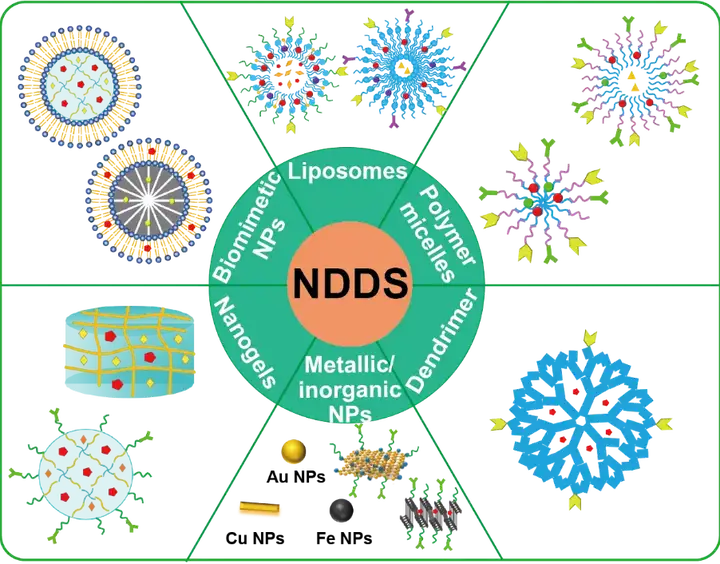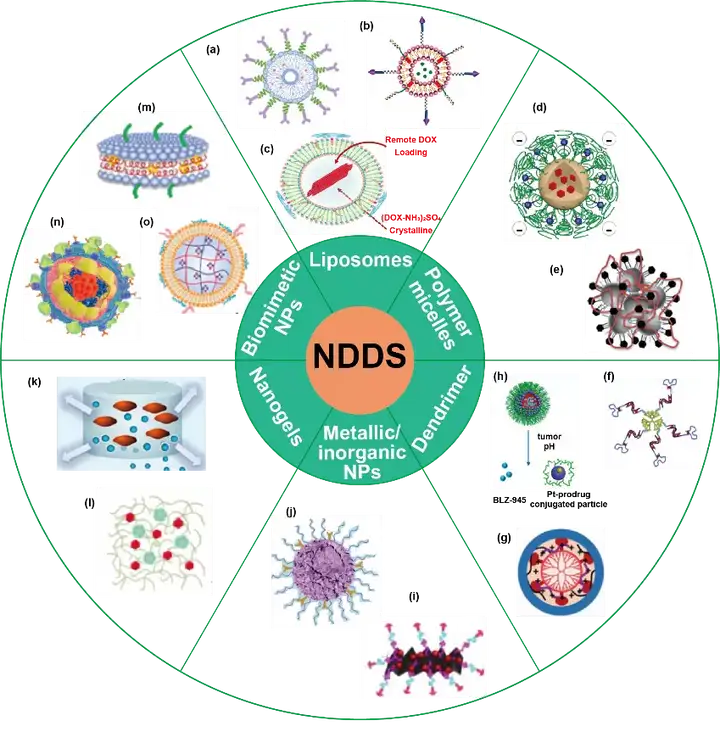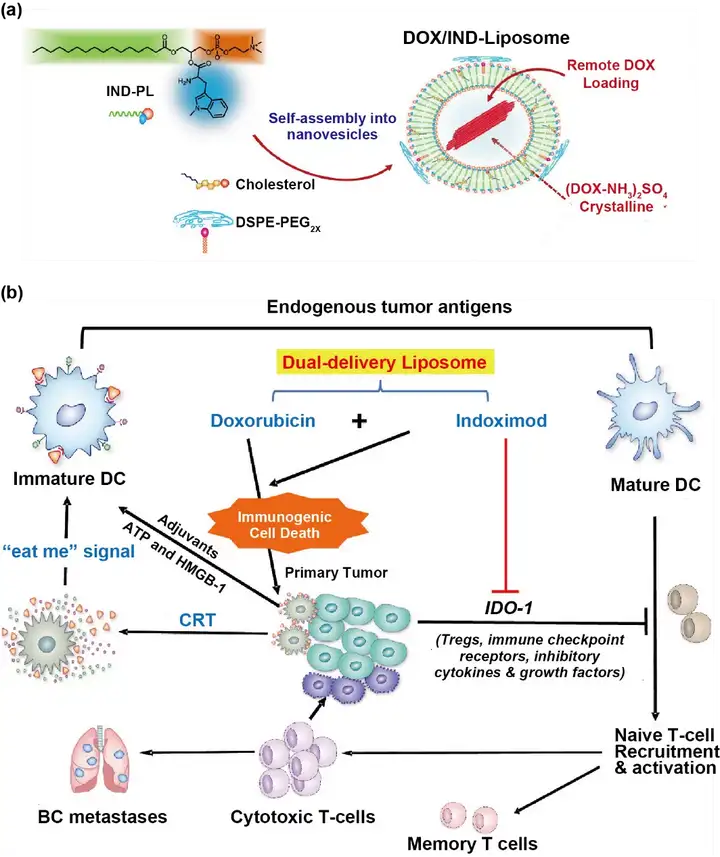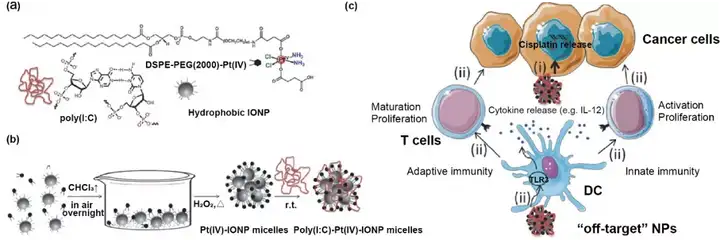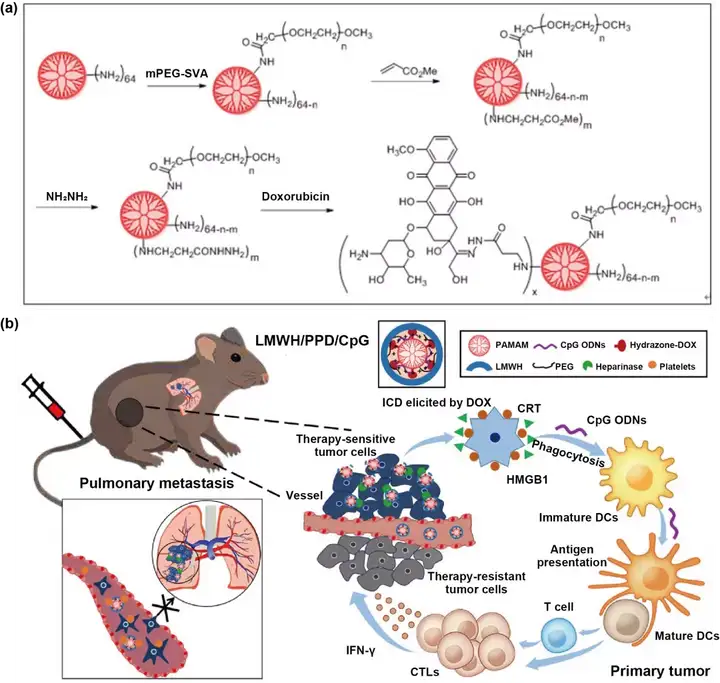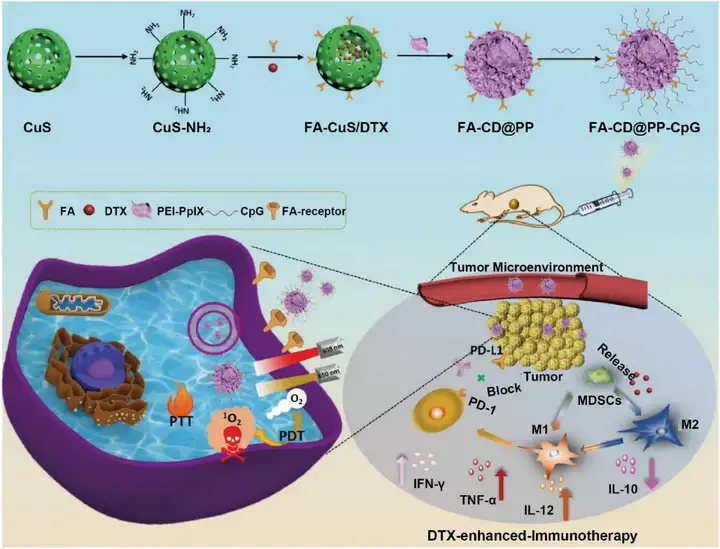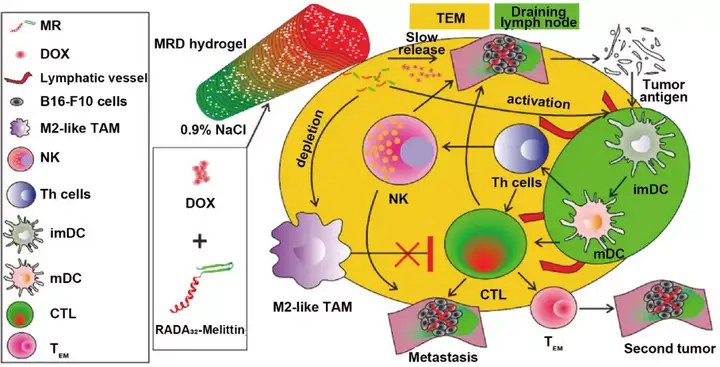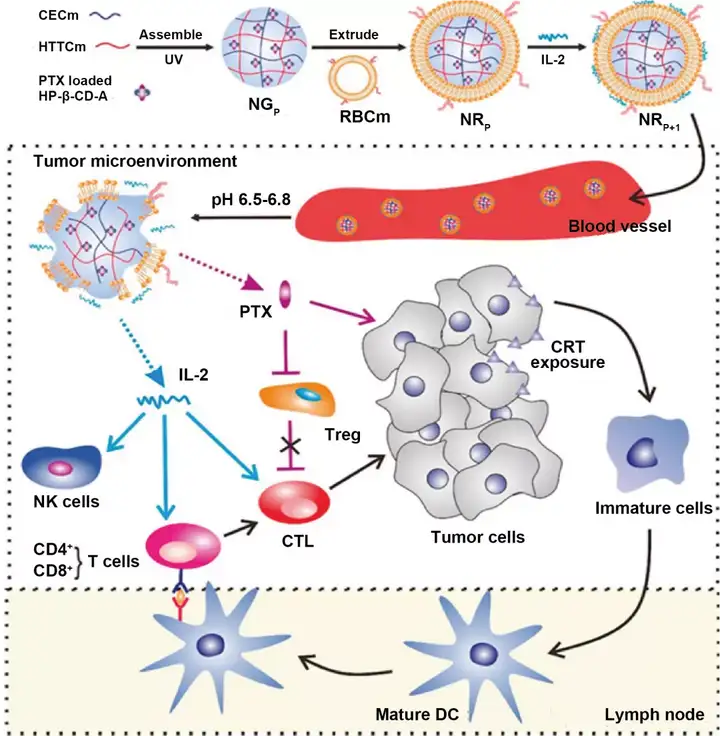已传文件:photo/1631586161.png
Chemotherapy and immune combination therapy has the advantages of synergistic treatment mechanism, reduction of drug dosage and enhancement of treatment effect, and it is a promising tumor treatment method. However, the pharmacokinetic properties and distribution in the body of the two therapeutic agents are different, the target points of action are inconsistent, the proportion of drugs at the tumor site is uncontrollable, and the severe systemic side effects affect the synergistic anti-tumor effect. Nano-drug delivery systems are used for the delivery of chemotherapy and immunotherapeutics due to their improved drug pharmacokinetic properties, tumor-targeted delivery capability, tumor microenvironmental responsiveness and targeted drug release, which helps to obtain better synergistic anti-tumor effects The effect has potential clinical application prospects.
A Review on Nano-Based Drug Delivery System for Cancer ChemoimmunotherapyWeiwei Mu, Qihui Chu, Yongjun Liu, Na Zhang*
Nano‑Micro Lett.(2020)12:142
https://doi.org/10.1007/s40820-020-00482-6
Highlights of this article
1. This article summarizes the current methods of tumor immunotherapy.
2. Discuss the research status and application prospects of tumor chemoimmunotherapy.
3. Discuss and explain the latest research progress of nano-drug delivery system for tumor chemoimmunotherapy.
brief introduction
The team of Professor Zhang Na from the Institute of Pharmaceutics, School of Pharmacy, Shandong University reviewed and systematically summarized the latest research progress in the application of nano-drug delivery systems to tumor chemo-immunotherapy.
Immunotherapy is a new type of treatment that regulates the immune system instead of focusing on the tumor cells themselves. It is the latest effective method of tumor treatment. However, the resistance of immune checkpoint inhibitors, the weak immunogenicity of therapeutic vaccines, off-target effects, and serious immune-related adverse events (iRAE) have challenged the immunotherapy of certain tumor types or patients.
A large number of preclinical studies have proved that chemotherapy may provide additional help for immunotherapy. Some cytotoxic drugs can stimulate anti-tumor immunity. For example, CDK4/6 inhibitors can stimulate the production of IFN-III and enhance tumor antigen presentation. A reasonable combination of chemical and immunotherapy can synergistically improve the anti-tumor effect.
In order to ensure the best synergistic anti-tumor effect of chemo-immunization, it is necessary to pay attention to the difference in pharmacokinetic properties and distribution of the two drugs in the combined process, tumor targeting specificity and tumor accumulation, and the proportion of drugs in tumor tissue is uncertain. , And serious systemic side effects and other problems. Nano drug delivery system (NDDS) can improve the pharmacokinetic behavior of drugs in the body, increase drug stability, achieve targeted drug delivery and drug controlled release, and has broad application prospects in the field of combined chemotherapy and immunotherapy. The application of NDDS to chemo-immunotherapy is the current research hotspot in tumor therapy. This article reviews the latest research progress in the application of NDDS to tumor chemotherapy and immunotherapy.
Graphic guide
I Tumor immunotherapy
Tumor immunity includes several key steps such as the release of tumor cell antigens, antigen presentation cells presenting antigens, T cell initiation and activation, T cell migration and infiltration into tumor tissues, and the recognition and killing of tumor cells by cytotoxic T cells. Each step may become a potential therapeutic target. Aiming at these targets, current tumor immunotherapy methods mainly include therapeutic antibodies, tumor vaccines, adoptive cell therapy and cytokine therapy.
II Tumor Chemoimmunotherapy Combination Therapy
Tumor chemoimmunotherapy is a promising method to improve the efficacy of anti-tumor. Chemotherapy drugs may regulate tumor immunity by enhancing the immunogenicity of tumor cells and affecting the functions of immune cells such as regulatory T cells (Treg), myeloid-derived suppressor cells (MDSCs) and dendritic cells (DCs). Studies have shown that appropriate doses of chemotherapeutics can enhance the endogenous immunogenicity of tumor cells by up-regulating the expression of tumor antigens and MHC-I, inducing the expression of costimulatory molecules, and down-regulating the expression of immune checkpoint molecules on the surface of tumor cells. . Appropriate dose of chemotherapeutic drugs can adjust the inhibitory effect of Treg. For example, the results of the study on the treatment of mice with MMTV-RTTA/Teto-HER2 tumors by the combination of pomazenil and PD-L1 inhibitors showed that the two-drug combination and single-drug treatment had enhanced therapeutic effects, and the tumor volume decreased on the 13th day. ~70%.
Clinical trials of tumor chemoimmunotherapy have also shown promising results. Studies have shown that in the treatment of malignant pleural mesothelioma with CD40 antibody combined with cisplatin/pemetrexed, more patients have a transient tumor-specific T cell immune response, and three patients have achieved long-term survival (more than 30 months). The combination of carboplatin or cisplatin and pemetrexed combined with pembrolizumab has been approved by the FDA as a first-line treatment for patients with metastatic, non-squamous non-small cell lung cancer.
However, there are also some clinical trials of combined chemo-immune treatment for tumors that are not satisfactory, with large differences in efficacy between patients, and many patients have poor immune responses. Therefore, it is necessary to explore new strategies to further improve the immune response effect of the combined chemotherapy.
III Nano-drug delivery system for tumor chemotherapy and immunotherapy
NDDS provides a new way to improve the effect of combined chemotherapy and immunotherapy for tumors. At present, there are several flexible methods to use NDDS to achieve combined chemo-immunotherapy. For example, one drug can be administered in free form, the other drug can be administered via NDDS (Free drug+Nano), or two drugs can be delivered by similar or different NDDS (Nano+Nano), or two drugs Co-encapsulated in the same nanocarrier (co-encapsulation).
The Free drug+Nano strategy has the advantages of flexible and adjustable prescription, controllable dosing interval, simple preparation, easy industrialization and clinical transformation. The Nano+Nano strategy has the advantages of flexible formulation, adjustable dosage, and similar distribution of the two formulations. Our research team prepared twin-like nanoparticles (TCN) for different target cells, and targeted delivery of sorafenib to tumor cells and IMD-0354 to macrophages to enhance tumor chemotherapy and immunotherapy effects. The distribution of these two TCNs in the body is similar, which can achieve targeted delivery of different drugs to different cells, thereby ensuring a synergistic anti-tumor effect.
The co-encapsulation strategy can control the accumulation of drugs in tumor tissues, ensure the controlled release of drugs, and control the spatiotemporal delivery of multiple drugs. At present, a variety of NDDS have been used in chemical immune combination therapy, including liposomes, polymer micelles, dendrimers, metal and inorganic nanoparticles, nanogels and biomimetic nanoparticles, etc. (Figure 1) .
Figure 1. The NDDS co-encapsulation strategy is applied to tumor chemoimmunotherapy. 3.1 Liposome
Liposomes have the advantages of high encapsulation efficiency, good targeting, low toxicity, etc., and they have been widely studied as carriers of combined chemotherapy and immunity. Hydrophilic therapeutic agents can be encapsulated in liposomes, hydrophobic therapeutic agents can be encapsulated in lipid bilayers, and therapeutic agents can also interact with lipids through charge interactions or chemical interactions with lipid molecules. Links, loaded in liposomes or on the surface of liposomes. As shown in Figure 2, Lu et al. prepared a liposome (DOX/IND-liposome) containing doxorubicin and IDO-1 inhibitor (IND). DOX/IND-liposome self-assembles through phospholipid and IND coupling, and loads doxorubicin through active drug loading. The results showed that DOX/IND-liposome significantly enhanced the immune response against breast cancer.
Figure 2. Liposomes are used in tumor chemoimmunotherapy.
3.2 Polymer micelles
The polymer micelle has a hydrophobic inner core and a hydrophilic outer shell, and has the characteristics of simple preparation, simultaneous loading of multiple drugs and easy surface modification. Hydrophobic drugs can be encapsulated in the hydrophobic core of micelles, and hydrophilic drugs can be loaded by chemical coupling. When polymer micelles are used in tumor chemotherapy and immunotherapy, because of their small particle size, they are easy to penetrate into the lymph nodes along the lymphatic vessels, which is beneficial to the delivery of tumor antigens and immune adjuvants. Juan C. Mareque-Rivas et al. reported a Pt(IV) prodrug-modified PEGylated phospholipid micelle, which was coated with iron oxide nanoparticles (IONP) and modified with Poly(I:C) for use in tumors Chemoimmunotherapy. The micelles significantly enhanced the killing effect on tumor cells (Figure 3).
Figure 3. Polymer micelles are used in tumor chemoimmunotherapy.
3.3 Dendrimer
Dendritic polymers such as PAMAM, PEI, etc., have characteristics such as clear chemical structure, monodisperse, easy realization of multi-function and multivalent modification, etc., and have been widely studied. The hydrophobic core of the dendrimer can be loaded with small-molecule drugs, and the functionalized peripheral group can be chemically connected to immunotherapeutics, such as therapeutic antibodies. As shown in Figure 4, He et al. designed a nanoparticle (LMWH/PPD/CpG) based on PAMAM co-carrying doxorubicin and CpG for the combined chemotherapy and immunotherapy of metastatic melanoma. Doxorubicin is linked to the terminal amino group of PAMAM via a pH-sensitive hydrazone bond. Negatively charged low molecular weight heparin coats the surface of PAMAM to form LMWH/PPD/CpG. LMWH/PPD/CpG significantly enhanced the immune response and therapeutic effect of melanoma-bearing mice.
Figure 4. Dendrimers are used in tumor chemoimmunotherapy.
3.4 Metal/inorganic nanoparticles
Metal and inorganic nanoparticles usually have photothermal therapy (PTT) and photodynamic therapy (PDT) effects, with high drug loading, easy functional modification, and no immunogenicity. They are both good drug carriers and tumor therapeutics. At present, many metal and inorganic nanoparticles have been used in the research of chemical immunotherapy, including graphene oxide nanoparticles, mesoporous silica nanoparticles, black phosphorus nanoparticles, gold nanoparticles and copper nanoparticles. Dong et al. designed multifunctional CuS nanoparticles (FA-CD@PP-CpG) for co-delivery of CpG and docetaxel, and coordinated with PDT and PTT to obtain enhanced breast cancer treatment effects. FA-CD@PP-CpG can promote CTL infiltration, inhibit MDSCs, and improve the anti-tumor effect of 4T1- tumor-bearing mice (Figure 5).
Figure 5. Metal nanoparticles are used in tumor chemoimmunotherapy.
3.5 Nanogel
Nanogels are hydrogel scaffolds with nanometer scale, which have good biocompatibility, high water content and good compatibility with various therapeutic agents (such as small molecule drugs and biomacromolecule drugs), and are widely used Chemoimmunotherapy combined therapy research. By means of targeted ligand modification and responsive functional bond synthesis, multifunctional nanogels can be rationally designed to improve the effect of combined chemical and immune therapy. Yang et al. reported a melittin-RADA32 hydrogel loaded with doxorubicin, which enhances the effect of chemo-immunotherapy by actively adjusting the tumor microenvironment. The hydrogel enhances the killing effect on melanoma by controlling drug release, regulating innate immune cells (such as promoting DC maturation) and depleting M2 macrophages (Figure 6).
Figure 6. Nanogels are used in tumor chemoimmunotherapy.
3.6 Bionic nanocarrier
The biomimetic nanocarrier has a natural-like structure or shape, surface properties and size, has stronger targeting and good biocompatibility, and can deliver drugs to target cells or tissues. Bionic nanoparticles prepared from albumin, high-density lipoprotein, low-density lipoprotein, transferrin family proteins and their derivatives have been used in the research of tumor chemical immunotherapy. Cell membrane bionic nanoparticles are mainly composed of functional nanoparticles wrapped in cell membranes. The cell membrane protein on the cell membrane bionic nanoparticle maintains its biological activity, so that the cell membrane bionic nanoparticle has the ability of immune escape, prolonging blood circulation time and tumor targeting. Different cell membranes make biomimetic nanoparticles have different functions in tumor treatment. Red blood cell membrane biomimetic nanoparticles can improve biocompatibility and biodegradability, and prolong blood circulation time. Zhang et al. developed a red blood cell membrane coated nanoparticles (NRP+I) for co-delivery of docetaxel and IL-2 (Figure 7). The biomimetic nanoparticle NRP+I has enhanced anti-tumor immune effect and deep penetration of drug tumor tissues.
Figure 7. Biomimetic nanocarriers used in tumor chemotherapy and immunotherapy.
IV Summary and Prospects The application of NDDS in tumor chemotherapy and immunotherapy is full of opportunities, but also faces huge challenges:
1) Although NDDS has advantages in breaking the tumor immune balance, eliminating tumors, and inhibiting tumor metastasis, the increased accumulation of immunotherapeutic drugs at tumor sites may induce autoimmune diseases and increase the occurrence of iRAE.
2) Chemotherapeutic drugs and immunotherapeutic drugs usually have different target cells. The NDDS co-encapsulation strategy is usually difficult to achieve precise delivery of different cells in tumor tissues, which may increase drug off-target effects. Therefore, the rational design of NDDS with timed and quantitative drug release to achieve precise targeting of different drugs to different cells is a new direction for tumor chemical immunotherapy research.
3) Due to the complexity of the process, the inevitable drug leakage, the safety of excipients, and the poor stability, the clinical transformation of NDDS still faces major obstacles. NDDS with simple design prescription, mature preparation process, good biocompatibility and easy industrial production is still a hot and difficult point in tumor treatment research.
This information is sourced from the Internet for academic exchanges only. If there is any infringement, please contact us to delete it immediately.


